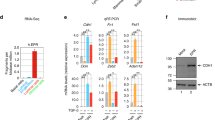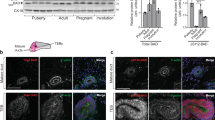Abstract
ZBP-89 (ZNF148) is a Zinc finger Binding Protein of 89 kDa that binds GC-rich DNA elements. Originally, it was expression cloned using a DNA element mediating EGF regulation of the gastrin promoter. ZBP-89 functions as both a transcriptional activator and repressor. A variety of extracellular regulators including TGFβ, retinoic acid and butyrate stimulate ZBP-89 gene expression. Butyrate activation of p21WAF1 is potentiated by ZBP-89 gene expression correlating with cell differentiation. ZBP-89 stimulates growth arrest and apoptosis through its ability to bind the p21WAF1 promoter or its ability to form protein-protein interactions with p53. ZBP-89 protein is elevated in a variety of gastrointestinal cancers as well as the pancreas. In particular, ZBP-89 is normally expressed in pancreatic islets and ducts and in about 30% of pancreatic adenocarcinomas.
Similar content being viewed by others
References
Sakorafas GH, Tsiotou AG, Tsiotos GG. Molecular biology of pancreatic cancer; oncogenes, tumour suppressor genes, growth factors, and their receptors from a clinical perspective. Cancer Treat Rev 2000;26:29–52.
Bai L, Merchant JL. ZBP-89 Promotes Growth Arrest through Stabilization of p53. Mol Cell Biol 2001;21:4670–4683.
Merchant JL, Iyer GR, Taylor BR, et al. ZBP-89, a Kruppel-type zinc finger protein, inhibits EGF induction of the gastrin promoter. Mol Cell Biol 1996;16:6644–6653.
Hasegawa T, Takeuchi A, Miyaishi O, Isobe K-I, Crombrugghe BD. Cloning and characterization of a transcription factor that binds to the proximal promoters of the two mouse type I collagen genes. J Biol Chem 1997;272:4915–4923.
Passantino R, Antona V, Barbieri G et al. Negative regulation of β enolase gene transcription in embryonic muscle is dependent upon a zinc finger factor that binds to the G-rich box within the muscle-specific enhancer. J Biol Chem 1998;273:484–494.
Wang Y, Kobori TA, Hood L. The htβ gene encodes a novel CACCC boxbinding protein that regulates T-cell receptor gene expression. Mol Cell Biol 1993;13:5691–5701.
Law GL, Itoh H, Law DJ, Mize GJ, Merchant JL, Morris DR. Transcription factor ZBP-89 regulates the activity of the ornithine decarboxylase promoter. J Biol Chem 1998;273:19,955–19,964.
Reizis B, Leder P. Expression of the mouse pre-TCR alpha gene is controlled by an upstream region containing a transcriptional enhancer. J Exp Med 1999;189:1669–1678.
Yamada A, Takaki S, Hayashi F, Georgopoulos K, Perlmutter RM, Takatsu K. Identification and characterization of a transcriptional regulator for the lck proximal promoter. J Biol Chem 2001;276:18,082–18,089.
Law DJ, Tarle SA, Merchant JL. The human ZBP-89 homolog, located at chromosome 3q21, represses gastrin gene expression. Mamm Genome 1998;9:165–167.
Bellefroid EJ, Lecocq PJ, Benhida A, Poncelet DA, Belayew A, Martial JA. The human genome contains hundreds of genes coding for finger proteins of the Kruppel type. DNA 1989;8:377–387.
Schamhorst V, van der Eb AJ, Jochemsen AG. WT1 proteins: functions in growth and differentiation. Gene 2001;273:141–161.
Black AR, Black JD, Azizkhan-Clifford J. Spl and kruppellike factor family of transcription factors in cell growth regulation and cancer. J Cell Physiol 2001;188:143–160.
Ye S, Whatling C, Watkins H, Henney A. Human stromelysin gene promoter activity is modulated by transcription factor ZBP-89. FEBS Lett 1999;450:268–272.
Remington MC, Tarle SA, Simon B, Merchant JL. ZBP-89, a Kruppel-type zinc finger protein, inhibits cell proliferation. Biochem Biophys Res Commun 1997;237:230–234.
Dawson MI, Park JH, Chen G et al. Retinoic acid (RA) receptor transcriptional activation correlates with inhibition of 12-O-tetradecanoylphorbol-13-acetate-induced ornithine decarboxylase (ODC) activity by retinoids: a potential role for trans-RA-induced ZBP-89 in ODC inhibition. Int J Cancer 2000;91:8–21.
Merchant JL, Bai L, Law D. Zinc finger factor ZBP-89 is regulated by TGF beta and during gastric transformation. Cancer Detect Prevent 1998;22:S109.
Hahn SA, Schutte M, Hoque AT et al. DPC4, a candidate tumor suppressor gene at human chromosome 18q21.1. Science 1996;271:350–353.
Scaglia L, Smith FE, Bonner-Weir S. Apoptosis contributes to the involution of beta cell mass in the post partum rat pancreas. Endocrinology 1995;136:5461–5468.
Miralles F, Battelino T, Czemichow P, Scharfmann R. TGF-beta plays a key role in morphogenesis of the pancreatic islets of Langerhans by controlling the activity of the matrix metalloproteinase MMP-2. J Cell Biol 1998;143:827–836.
Muller-Pillasch F, Gress TM, Yamaguchi H, Geng M, Adler G, Menke A. The influence of transforming growth factor beta 1 on the expression of genes coding for matrix metalloproteinases and tissue inhibitors of metalloproteinases during regeneration from cerulein-induced pancreatitis. Pancreas 1997;15:168–175.
Kerr LD, Miller DB, Matrisian LM. TGF-beta 1 inhibition of transin/stromelysin gene expression is mediated through a Fos binding sequence. Cell 1990;61:267–278.
Bai L, Merchant JL. Transcription factor ZBP-89 cooperates with histone acetyltransferase p300 during butyrate activation of p21 waf1 transcription in human cells. J Biol Chem 2000;275:30,725–30,733.
Bamard JA, Warwick G. Butyrate rapidly induces growth inhibition and differentiation in HT-29 cells. Cell Gorwth Differ 1993;4:495–501.
Mandal M, Kumar R. Bcl-2 expression regulates sodium butyrate-induced apoptosis in human MCF-7 breast cancer cells. Cell Growth Differ 1996;7:311–318.
Bernhard D, Ausserlechner MJ, Tonko M, et al. Apoptosis induced by the histone deacetylase inhibitor sodium butyrate in human leukemic lymphoblasts. FASEB J 1999;13:1991–2001.
Giuliano M, Lauricella M, Calvaruso G, et al. The apoptotic effects and synergistic interaction of sodium butyrate and MG132 in human retinoblastoma Y79 cells. Cancer Res 1999;29:5586–5595.
Archer SY, Meng S, Shei A, Hodin RA. p21 (WAF1) is required for butyrate-mediated growth inhibition of human colon cancer cells. Proc Natl Acad Sci USA 1998;95:6791–6796.
Gartel AL, Tyner AL. Transcriptional regulation of the p21 (WAF1/CIP1) gene. Exp Cell Res (1999);246:280–289.
Hasegawa T, Xiao H, Isobe K-i. Cloning of a GADD34-like gene that interacts with the zinc-finger transcription factor which binds to the p21 WAF promoter. Biochem Biophys Res Commun 1999;256:249–254.
Prives C, Hall PA. The p53 pathway. J Pathol 1999;187:112–126.
Gorunova L, Hoglund M, Andren-Sandberg A, et al. Cytogenetic analysis of pancreatic carcinomas: intratumor heterogeneity and nonrandom pattern of chromosome aberrations. Genes Chromosomes Cancer 1998;23:81–99.
Taniuchi T, Mortensen ER, Ferguson A, Greenson J, Merchant JL. Overexpression of ZBP-89, a zinc finger DNA binding protein, in gastric cancer. Biochem Biophys Res Commun 1997;233:154–160.
Traber PG, Silberg DG. Intestine-specific gene transcription. Annu Rev Physiol 1996;58:275–297.
Antona V, Cammarata G, De Gregorio L, Dragani TA, Giallongo A, Feo S. The gene encoding the transcriptional repressor BERF-1 maps to a region of conserved synteny on mouse chromosome 16 and human chromosome 3 and a related pseudogene maps to mouse chromosome 8. Cytogenet Cell Genet 1998;83:90–92.
Feo S, Antona V, Cammarata G et al. Conserved Structure and Promoter Sequence Similarity in the Mouse and Human Genes Encoding the Zinc Finger Factor BERF-1/BFCOL1/ZBP-89. Biochem Biophys Res Commun 2001;283:209–218.
Law DJ, Du M, Law GL, Merchant JL. ZBP-99 defines a conserved family of transcription factors and regulates ornithine decarboxylase gene expression. Biochem Biophys Res Commun 1999;262:113–120.
Lisowsky T, Polosa PL, Sagliano A, Roberti M, Gadaleta MN, Cantatore P. Identification of human GC-box-binding zinc finger protein, a new Kruppel-like zinc finger protein, by the yeast one-hybrid screening with a GC-rich target sequence. FEBS Lett 1999;453:369–374.
Cordon-Cardo C, Latres E, Drobnjak M, et al. Molecular abnormalities of mdm2 and p53 genes in adult soft tissue sarcomas. Cancer Res 1994;54:794–799.
Moll UM, LaQuaglia M, Benard J, Riou G. Wild-type p53 protein undergoes cytoplasmic sequestration in undifferentiated neuroblastomas but not in differentiated tumors. Proc Natl Acad Sci USA 1995;92:4407–4411.
Larsson LI, Rehfeld JF, Sundler F, Hakanson R. Pancreatic gastrin in foetal and neonatal rats. Nature 1976;262:609–610.
Brand SJ, Fuller PJ. Differential gastrin gene expression in rat gastrointestinal tract and pancreas during neonatal development. J Biol Chem 1988;263:5341–5347.
Wang TC, Bonner-Weir S, Oates PS, et al. Pancreatic gastrin stimulates islet differentiation of transforming growth factor alpha-induced ductular precursor cells. J Clin Invest 1993;92:1349–1356.
Caplin M, Savage K, Khan K, et al. Expression and processing of gastrin in pancreatic adenocarcinoma. Br J Surg 2000;87:1035–1040.
Smith JP, Fantaskey AP, Liu G, Zagon IS. Indentification of gastrin as a growth peptide in human pancreatic cancer. Am J Physiol 1995;268:R135-R141.
Roebuck BD, Baumgartner KJ, Longnecker DS. Growth of pancreatic foci and development of pancreatic cancer with a single dose of azaserine in the rat. Carcinogenesis 1987;8:1831–1835.
Smith JP, Shih A, Wu Y, McLaughlin PJ, Zagon IS. Gastrin regulates growth of human pancreatic cancer in a tonic and autocrine fashion. Am J Physiol 1996;270:R1078-R1084.
Brett B, Savage K, Michaeli D, Grimes S, Dhillon AP, Pounder RE. The effect of antibodies raised against gastroimmune on the proliferation of human pancreatic carcinoma cell lines. Gut 1999;44:A48.
Hasegawa T, Takeuchi A, Miyaishi O, Xiao H, Mao J, Isobe K. PTRF (polymerase I and transcript-release factor) is tissue-specific and interacts with the BFCOL1 (binding factor of a type-I collagen promoter) zinc-finger transcription factor which binds to the two mouse type-I collagen gene promoters. Biochem J 2000;347:55–59.
Cheng PY, Kagawa N, Takahashi Y, Waterman MR. Three Zinc Finger Nuclear Proteins, Spl, Sp3, and aZBP-89 Homologue, Bind to the Cyclic Adenosine Monophosphate-Responsive Sequence of the Bovine Adrenodoxin Gene and Regulate Transcription. Biochemistry 2000;39:4347–4357.
Keates AC, Keates S, Kwon JH, et al. ZBP-89, Spl, and nuclear factor-kappa B regulate epithelial neutrophilactivating peptide-78 gene expression in Caco-2 human colonic epithelial cells. J Biol Chem 2001;276:43,713–43,722.
Baumann M., Feederle R, Kremmer E, Hammerschmidt W. Cellular transcription factors recruit viral replication proteins to activate the Epstein-Barr virus origin of lytic DNA replication, oriLyt. EMBO J 1999;18(12):6095–6105.
Wieczorek E, Lin Z, Perkins EB, Law DJ, Merchant JL, Zehner ZE. The zinc finger repressor, ZBP-89, binds to the silencer element of the human vimentin gene and complexes with the transcriptional activator, Sp1. J Biol Chem 2000;275(17):12879–12888.




